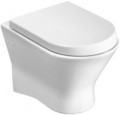Rimless
Toilets of special design, in which the bowl
has no rim.
The back of the rim is one of the worst places in the entire toilet facility: contamination and micro-organisms accumulate easily and at the same time it is difficult to get there during cleaning. In light of this, some manufacturers produce toilets without rims - this reduces the number of hard to reach places, makes the product more hygienic in general and facilitates its cleaning.
Toilet material
—
Sanitaryware(“sanitary faience”). The most common material for modern toilets, at a low cost, has a neat appearance, is durable and reliable. The main disadvantage is the porous structure, which contributes to the accumulation of dirt and odors (although recently technologies have been applied to eliminate this disadvantage). The service life of such material in modern toilets can reach 40 years.
—
Sanfarfor(“sanitary porcelain”). Like sanitary ware, it belongs to ceramic materials, however, with similar strength and appearance, it absorbs water and dirt much less easily, due to which it has a longer service life - up to 60 years. However, sanitary porcelain is also more expensive.
- Stainless steel. The key advantage of “stainless steel” is its high strength: this material can easily withstand even strong impacts that can crack sanitary porcelain or sanitaryware. On the other hand, such toilets are not cheap, despite the fact that the mentioned strength in reality is not needed so often. Therefore, it makes sense to pay attention to this option in cases where reliability and resistance to damage are of key importance - for example, if plumbing fixtures are purchased for a stadium, bar, etc., and must be vandal-resistant.
- Ceramics. These or other types of ceramics that either do not belong to the sanitary porcelain or sanitary ware described above, or represent specific v
...arieties of these materials. The specific features of ceramic toilets should be clarified separately; however, for the most part these are quite advanced and high-quality products.
Moreover, each of the listed materials may additionally have a special antibacterial toilet coating that prevents the growth and reproduction of bacteria. It significantly improves the hygiene of use, but affects the price.Seat material
The material from which the toilet seat is made.
-
Duroplast. In appearance, Duroplast seats resemble ceramics. They look much more expensive than traditional plastic seats, and duroplast also has high strength, durability, resistance to impacts, ultraviolet rays and aggressive detergents. It's also heavy material. It is important to consider that in models without a closer, the duroplast seat and its cover can hit the toilet hard when lowered.
—
Polypropylene. The seats are made of plastic, often called thermoplastic. This is a cheap, lightweight and easy-to-clean toilet seat material. Polypropylene can be quite strong and stable, but over time such products often become yellow, and plastic seats can become deformed, scratched and broken due to mechanical damage.
The listed materials may additionally have a special antibacterial coating that prevents the growth and reproduction of bacteria. It significantly improves the hygiene of using the toilet, but it does come at a price.
Dimensions (HxWxD)
General dimensions of the toilet bowl in height, width and depth (by depth is meant the distance from the front edge to the rear edge).
These indicators allow you to determine how much space is required to install the product, and also affect some practical points. In this case, width and depth are of key importance. Specific figures and nuances for these dimensions are as follows:
- Width:
up to 35 cm in the narrowest models,
40 cm or more in the widest, intermediate options -
36 - 37 cm and
38 - 39 cm. A large width is desirable if people of large build will use the toilet. However, it should be borne in mind that this dimensions is indicated by the widest part of the structure, and this is not necessarily a bowl - we can talk about a tank.
- Depth:
up to 50 cm - is considered small, in the largest products -
more than 65 cm ; intermediate options include
51 - 55 cm,
56 - 60 cm and
61 - 65 cm. Here the choice depends on the height and physique of the user: tall people and people with long legs will be most comfortable with toilets with great depth.
Height is worth mentioning. In models without a tank, it corresponds to the height of the bowl
..., see more about this indicator above. In compact toilets (see "Type"), the height with the tank is usually indicated, it depends on how much vertical space is required for installation. Here, an indicator of 75 cm or less is considered small, 76 - 80 cm is average, 81 - 85 cm is above average, and for the highest products, more than 85 cm of free space above the floor will be required.
